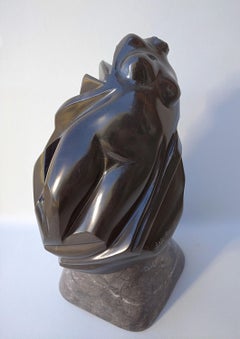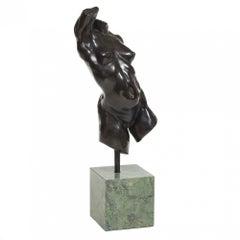Lutfi Romhein Nude Sculptures
b. 1954
Lutfi Romhein is a sculptor of Syrian origin, living in France since the mid-2000s. He was born in Syria in 1954. Lutfi Romhein likes to explore a diversity of styles and materials like marble, fine woods, stainless steel, slate and Plexiglas. Romhein is particularly renowned in Syria, the Middle East and Italy.
to
1
Overall Width
to
Overall Height
to
1
1
1
1
1
1
11
86
31
28
23
1
Artist: Lutfi Romhein
"Buste Emporté", Sensual Black Marble Nude Female Bust Figurative Sculpture
By Lutfi Romhein
Located in Clermont-Ferrand, Auvergne-Rhône-Alpes
This figurative sculpture by Lutfi Romhein depicts a female nude bust in Belgian black marble mounted on a grey marble base. It has a very fine grain which provides a really soft tou...
Category
2010s Modern Lutfi Romhein Nude Sculptures
Materials
Marble
Related Items
Nude Female Torso Bronze Sculpture, 20th Century Contemporary American Artist
Located in Beachwood, OH
Alan Cottrill (American, Ohio, b. 1952)
Nude Female Torso, 1994
Bronze mounted to green marble base
Signed, dated and numbered 14/20 verso of leg, with foundry stamp
17. in. h. x 6 i...
Category
1990s Lutfi Romhein Nude Sculptures
Materials
Marble, Bronze
$2,500
H 25.5 in W 6 in D 6 in
Profundus Bronze Sculpture Nude Boy Contemporary Male Figure Marble Stone
By Wim van der Kant
Located in Utrecht, NL
Profundus Bronze Sculpture Nude Boy Contemporary Male Figure Marble Stone
Wim van der Kant (1949, Kampen) is a selftaught artist. Next to his busy p...
Category
21st Century and Contemporary Contemporary Lutfi Romhein Nude Sculptures
Materials
Marble, Bronze
$16,423
H 22.05 in W 22.05 in
Crepis Bronze Sculpture Nude Boy Male Figure Marble Stone
By Wim van der Kant
Located in Utrecht, NL
Crepis Bronze Sculpture Nude Boy Male Figure Marble Stone
Wim van der Kant (1949, Kampen) is a selftaught artist. Next to his busy profession as a teacher at...
Category
21st Century and Contemporary Contemporary Lutfi Romhein Nude Sculptures
Materials
Marble, Bronze
$16,423
H 17.72 in W 7.88 in
Aestus Bronze Sculpture Marble Stone Nude Boy Contemporary
By Wim van der Kant
Located in Utrecht, NL
Aestus Bronze Sculpture Marble Stone Nude Boy Contemporary
Wim van der Kant (1949, Kampen) is a selftaught artist. Next to his busy profession as a teacher ...
Category
21st Century and Contemporary Contemporary Lutfi Romhein Nude Sculptures
Materials
Marble, Bronze
$17,913
H 20.87 in W 3.94 in
Bufo Contemporary Bronze Sculpture Nude Boy Marble Stone Male Figure
By Wim van der Kant
Located in Utrecht, NL
Bufo Contemporary Bronze Sculpture Nude Boy Marble Stone Male Figure
Wim van der Kant (1949, Kampen) is a selftaught artist. Next to his busy profession as a teacher at a high school, he intensively practises his profession as a sculptor. Only when his work would measure up to his own standards, he decided to present it to the rest of the world. In 1995, he exhibited for the first time with Morren Galleries. Van der Kant desires to sculpt young people who still stand uninhibited and curiously in life. The reason he chooses to sculpt boys is, because he is one himself, this way the subject is closer to him. The anatomy of his figures testify of perfectionism. Van der Kant's subjects show similarities with the sculptures from the Greek and Roman antiquity...
Category
21st Century and Contemporary Contemporary Lutfi Romhein Nude Sculptures
Materials
Marble, Bronze
$10,694
H 12.21 in W 7.88 in
Gallulus Bronze Sculpture Nude Boy Male Figure Green Patina Marble Stone
By Wim van der Kant
Located in Utrecht, NL
Gallulus Bronze Sculpture Nude Boy Male Figure Green Patina Marble Stone
Wim van der Kant (1949, Kampen) is a selftaught artist. Next to his busy profess...
Category
21st Century and Contemporary Contemporary Lutfi Romhein Nude Sculptures
Materials
Marble, Bronze
$9,632
H 16.54 in W 7.88 in
Early 19th century Romantic marble sculpture - Kiss figures
Located in Varmo, IT
White marble sculpture - The Kiss. 19th century.
15 x 20 x h 20 cm including base, 12 x 17 x h 18 cm excluding base.
Entirely in white marble, some small breaks and repairs.
- ...
Category
Early 19th Century Romantic Lutfi Romhein Nude Sculptures
Materials
Marble
$2,364 Sale Price
20% Off
H 7.88 in W 5.91 in D 7.88 in
Aquila Bronze Sculpture Nude Boy Marble Stone Contemporary In Stock
By Wim van der Kant
Located in Utrecht, NL
Aquila Bronze Sculpture Nude Boy Marble Stone Contemporary In Stock - Sculpture without Stone is 57 cm high
Wim van der Kant (1949, Kampen) is a selftaught a...
Category
21st Century and Contemporary Contemporary Lutfi Romhein Nude Sculptures
Materials
Marble, Bronze
$16,925
H 27.56 in W 7.88 in D 7.88 in
Psyche Revived by Cupid's Kiss, Large Marble Sculpture after Canova, 19th C.
By Antonio Canova
Located in Beachwood, OH
After Antonio Canova (Italian, 1757-1822)
Psyche Revived by Cupid's Kiss
Marble
24 x 19 x 16 inches
135 lb.
The love affair between Cupid and Psyche is one of the best known classic...
Category
19th Century Lutfi Romhein Nude Sculptures
Materials
Marble
$15,000
H 24 in W 19 in D 16 in
Frine (Phryne), 19th Century Large Marble Sculpture of Nude Woman
Located in Beachwood, OH
Ercole Rosa (Italian, 1846 - 1893)
Frine (Phryne)
Marble
Signed 'E. Rosa, Studio O. Andreoni, Roma' on back
34.5 x 12 x 10 inches
80 lb.
Phryne was a 4th century BC famous Greek ...
Category
19th Century Italian School Lutfi Romhein Nude Sculptures
Materials
Marble
$35,000
H 34.5 in W 12 in D 10 in
Cursus Bronze Sculpture Contemporary Nude Boys Male Figures Marble Stone
By Wim van der Kant
Located in Utrecht, NL
Cursus Bronze Sculpture Contemporary Nude Boys Male Figures Marble Stone
Wim van der Kant (1949, Kampen) is a selftaught artist. Next to his busy profession...
Category
21st Century and Contemporary Contemporary Lutfi Romhein Nude Sculptures
Materials
Marble, Bronze
$18,660
H 18.12 in W 15.75 in
Allegorical mythological figurative bronze from the 19th century
Located in Florence, IT
Marble-based bronze statuette depicting Cupid, holding an arrow in his hand, walking caressing a lion's mane, lowered in the act of affectionately licking his little foot. The subjec...
Category
Mid-19th Century Romantic Lutfi Romhein Nude Sculptures
Materials
Marble, Bronze
$1,793
H 5.12 in W 6.3 in D 3.15 in
Lutfi Romhein nude sculptures for sale on 1stDibs.
Find a wide variety of authentic Lutfi Romhein nude sculptures available for sale on 1stDibs. You can also browse by medium to find art by Lutfi Romhein in marble, stone and more. Much of the original work by this artist or collective was created during the 21st century and contemporary and is mostly associated with the modern style. Not every interior allows for large Lutfi Romhein nude sculptures, so small editions measuring 5 inches across are available. Customers who are interested in this artist might also find the work of John W. Mills, and Benson Landes. Lutfi Romhein nude sculptures prices can differ depending upon medium, time period and other attributes. On 1stDibs, the price for these items starts at $2,487 and tops out at $2,487, while the average work can sell for $2,487.

